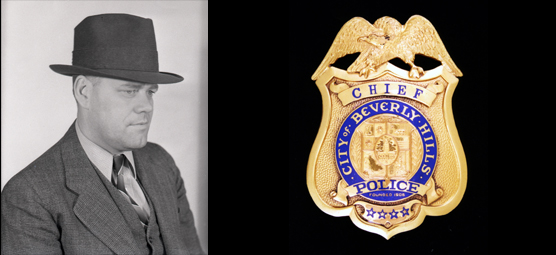Three Gangsters Gunned Down in Beverly Hills, Oh My!-September 25

Schroeder and Fogg will revisit celebrity crimes in Beverly Hills as they discuss and sign copies of their book Friday and Saturday, October 4-5. Book signing will be from 12 to 4 p.m. on Friday, October 4, with an Authors Talk set for 1-2 p.m. Saturday, October 5, followed by the book signing.
Chief Clinton H. Anderson: Chief of Police 1942 – 1969
Police Chief Clinton Anderson was not happy. It’s 1947 and in the last 18 months, three Mob figures have been shot in his city:
- Handsome bad boy Bugsy Siegel was liquidated in a barrage of bullets.
- Small-time gangster Pauley Gibbons was ambushed and slain near his apartment.
- The king of offshore gambling, Tony Cornero, had been shot once in the gut on the doorstep of his own fancy Beverly Hills home. (Cornero was the only one of the three who lived to not tell the tale of what happened to him.)
The Mob world was tough to infiltrate, making the chief’s job to protect and serve difficult. “It’s giving the city a bad name and there’s not a damn thing we can do about it!” he lamented.
So the chief tried some investigative tricks of his own, including a stinky escapade at Pauley Gibbons’ funeral. The chief and another officer infiltrated, undercover, Gibbon’s goodbye—maybe they’d find some clues, or other “clients” attending the somber event. As he wrote in his book, “Beverly Hills is My Beat,” Clinton and his partner were “listening to soft music from the organ… and there was a small commotion in the rear of the room. A newcomer arrived with another box of flowers to add to the floral display. He was a ragged, unshaven and dirty “stew bum” who teetered slightly as he handed a long carton to the attending mortician who noted it was unusually heavy for a box of roses. After the service, he asked us to inspect the package with him. It was decorated with a flossy card bearing this sentimental message: ‘To my pal.’ The mortician unwrapped it carefully, fearing a bomb…he lifted the lid and revealed the contents of the box. It was filled with horse manure.”
Anderson and his men never did find the sender, nor were they able to find Cornero’s triggerman or Siegel’s slayer. (To this day, this is still an unsolved case.)
The top cop hated how vice bosses had infiltrated his city, saying it was something the city didn’t deserve. But because those in the twilight underground were just enjoying the spoils of this rich little city, and not plying their tricks and trades in town, the “boys” were untouchable. “If (they) want to live in Beverly Hills, there’s nothing we can do about it,” said Clinton.
So Clinton instituted what townspeople liked to call “Anderson’s Law” directed at unsavory characters such as, for example, Mickey Cohen. “Now take Mickey Cohen, the bookie,” explained Clinton to a newspaper reporter, “We knew Mickey would jam himself up sometime soon, so we tailed him every night when he came home. We’d shake him down on his front doorstep. We made life so miserable for him that he moved out of the city.”
Chief Clinton Anderson retired in 1969 after 30 years on the force and died in 1989 at the age of 86. One officer noted at his funeral, “He gave his all to this city.”
Hear more about Bugsy Siegel’s slaying, and come see the actual bullet fragments and the contents of Bugsy’s wallet from the night he was shot, at the Mob Museum event for our book, “Beverly Hills Confidential: A Century of Stars, Scandals and Murder” on Oct. 4th and 5th
Feedback or questions? Email blog@themobmuseum.org





